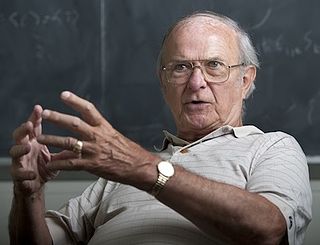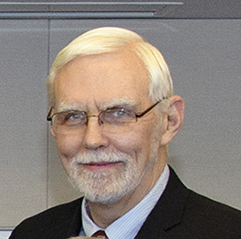Related Research Articles

In theoretical physics, quantum chromodynamics (QCD) is the theory of the strong interaction between quarks mediated by gluons. Quarks are fundamental particles that make up composite hadrons such as the proton, neutron and pion. QCD is a type of quantum field theory called a non-abelian gauge theory, with symmetry group SU(3). The QCD analog of electric charge is a property called color. Gluons are the force carriers of the theory, just as photons are for the electromagnetic force in quantum electrodynamics. The theory is an important part of the Standard Model of particle physics. A large body of experimental evidence for QCD has been gathered over the years.

Yang Chen-Ning or Chen-Ning Yang, also known as C. N. Yang or by the English name Frank Yang, is a Chinese theoretical physicist who made significant contributions to statistical mechanics, integrable systems, gauge theory, and both particle physics and condensed matter physics. He and Tsung-Dao Lee received the 1957 Nobel Prize in Physics for their work on parity non-conservation of weak interaction. The two proposed that one of the basic quantum-mechanics laws, the conservation of parity, is violated in the so-called weak nuclear reactions, those nuclear processes that result in the emission of beta or alpha particles. Yang is also well known for his collaboration with Robert Mills in developing non-abelian gauge theory, widely known as the Yang–Mills theory.

Gerardus (Gerard) 't Hooft is a Dutch theoretical physicist and professor at Utrecht University, the Netherlands. He shared the 1999 Nobel Prize in Physics with his thesis advisor Martinus J. G. Veltman "for elucidating the quantum structure of electroweak interactions".

David Jonathan Gross is an American theoretical physicist and string theorist. Along with Frank Wilczek and David Politzer, he was awarded the 2004 Nobel Prize in Physics for their discovery of asymptotic freedom. Gross is the Chancellor's Chair Professor of Theoretical Physics at the Kavli Institute for Theoretical Physics (KITP) of the University of California, Santa Barbara (UCSB), and was formerly the KITP director and holder of their Frederick W. Gluck Chair in Theoretical Physics. He is also a faculty member in the UCSB Physics Department and is currently affiliated with the Institute for Quantum Studies at Chapman University in California. He is a foreign member of the Chinese Academy of Sciences.
The J. J. Sakurai Prize for Theoretical Particle Physics, is presented by the American Physical Society at its annual April Meeting, and honors outstanding achievement in particle physics theory. The prize consists of a monetary award (US$10,000), a certificate citing the contributions recognized by the award, and a travel allowance for the recipient to attend the presentation. The award is endowed by the family and friends of particle physicist J. J. Sakurai. The prize has been awarded annually since 1985.

Carl Richard Hagen is a professor of particle physics at the University of Rochester. He is most noted for his contributions to the Standard Model and Symmetry breaking as well as the 1964 co-discovery of the Higgs mechanism and Higgs boson with Gerald Guralnik and Tom Kibble (GHK). As part of Physical Review Letters 50th anniversary celebration, the journal recognized this discovery as one of the milestone papers in PRL history. While widely considered to have authored the most complete of the early papers on the Higgs theory, GHK were controversially not included in the 2013 Nobel Prize in Physics.
William Allan Bardeen is an American theoretical physicist at Fermi National Accelerator Laboratory. He is the son of John Bardeen and Jane Maxwell Bardeen.

Richard Keith Ellis, is a British theoretical physicist, working at the University of Durham, and a leading authority on perturbative quantum chromodynamics and collider phenomenology.
The C. N. Yang Institute of Theoretical Physics (YITP) is a research center at Stony Brook University. In 1965, it was the vision of then University President J.S. Toll and Physics Department chair T.A. Pond to create an institute for theoretical physics and invite the famous physicist Chen Ning Yang from Institute for Advanced Study to serve as its director with the Albert Einstein Professorship of Physics. While the center is often referred to as "YITP", this can be confusing as YITP also stands for the Yukawa Institute for Theoretical Physics in Japan.

Mikhail "Misha" Arkadyevich Shifman is a theoretical physicist, formerly at Institute for Theoretical and Experimental Physics, Moscow, currently Ida Cohen Fine Professor of Theoretical Physics, William I. Fine Theoretical Physics Institute, University of Minnesota.
Warren Siegel is a theoretical physicist specializing in supersymmetric quantum field theory and string theory. He is a professor at the C. N. Yang Institute for Theoretical Physics at Stony Brook University in New York.
Michael John Creutz is an American theoretical physicist at Brookhaven National Laboratory specializing in lattice gauge theory and computational physics.
Alfred H. Mueller is an American theoretical physicist, and the Enrico Fermi Professor of Physics at Columbia University.
Davison "Dave" Eugene Soper is an American theoretical physicist specializing in high energy physics.
John Clements Collins is a British-born American theoretical physicist and professor of physics at Pennsylvania State University. He attended the University of Cambridge where he obtained a B.A. in mathematics 1971 and a Ph.D. in theoretical physics in 1975. He worked as a postdoc and assistant professor from 1975 to 1980 at Princeton University. Collins was part of the faculty of the Illinois Institute of Technology from 1980 to 1990. From 1990 to the present, he has been a faculty member in the department of physics at Pennsylvania State University where he currently holds the position of Distinguished Professor. He is a Fellow of the American Physical Society and received the Guggenheim Fellowship in 1986. In 2009, he was awarded the Sakurai Prize along with R. Keith Ellis and Davison E. Soper.
Bryan Ronald Webber, FRS, FInstP is a British physicist and academic. He was a Fellow of Emmanuel College, Cambridge from 1973 to 2010, and Professor of Theoretical Physics at the University of Cambridge from 1999 to 2010. He has been awarded the Dirac Medal by the Institute of Physics, the Sakurai Prize by the American Physical Society and the High Energy and Particle Physics Prize by the European Physical Society.
Stephen Bernard Libby is an American theoretical physicist and the Theory and Modeling Group Leader in the Physics Division at Lawrence Livermore National Laboratory. He is a Fellow of the American Physical Society. He is known for the application of quantum field theory to diverse systems including perturbative quantum chromodynamics and transport in the quantum Hall effect, as well as inventing computational algorithms for radiation driven kinetics in plasmas, and the invention of novel short wavelength laser applications.
Lance Jenkins Dixon is an American theoretical particle physicist. He is a professor in the SLAC Theory Group at the Stanford Linear Accelerator Center (SLAC) at Stanford University.
Zvi Bern is an American theoretical particle physicist. He is a professor at University of California, Los Angeles (UCLA).

G. Peter Lepage is a Canadian American theoretical physicist and an academic administrator. He was the Harold Tanner Dean of the College of Arts and Sciences at Cornell University from 2003 to 2013.
References
- ↑ The Institute for Advanced Study. Annual Report 1978/79, p. 55.
- ↑ Dragt, Alex. "Curriculum Vitae" (PDF). Retrieved 2017-07-08.
- ↑ Marquis Who's Who in Science and Engineering, 1st Edition. 2001.
- ↑ George Sterman at the Mathematics Genealogy Project
- 1 2 3 4 5 "2003 J. J. Sakurai Prize for Theoretical Particle Physics Recipient". APS. Retrieved 5 September 2010.
- ↑ "George Sterman Research profile" . Retrieved 5 September 2010.
- ↑ Sterman, George (1993). An introduction to quantum field theory. Cambridge University Press. p. 590. ISBN 978-0-521-32258-4.